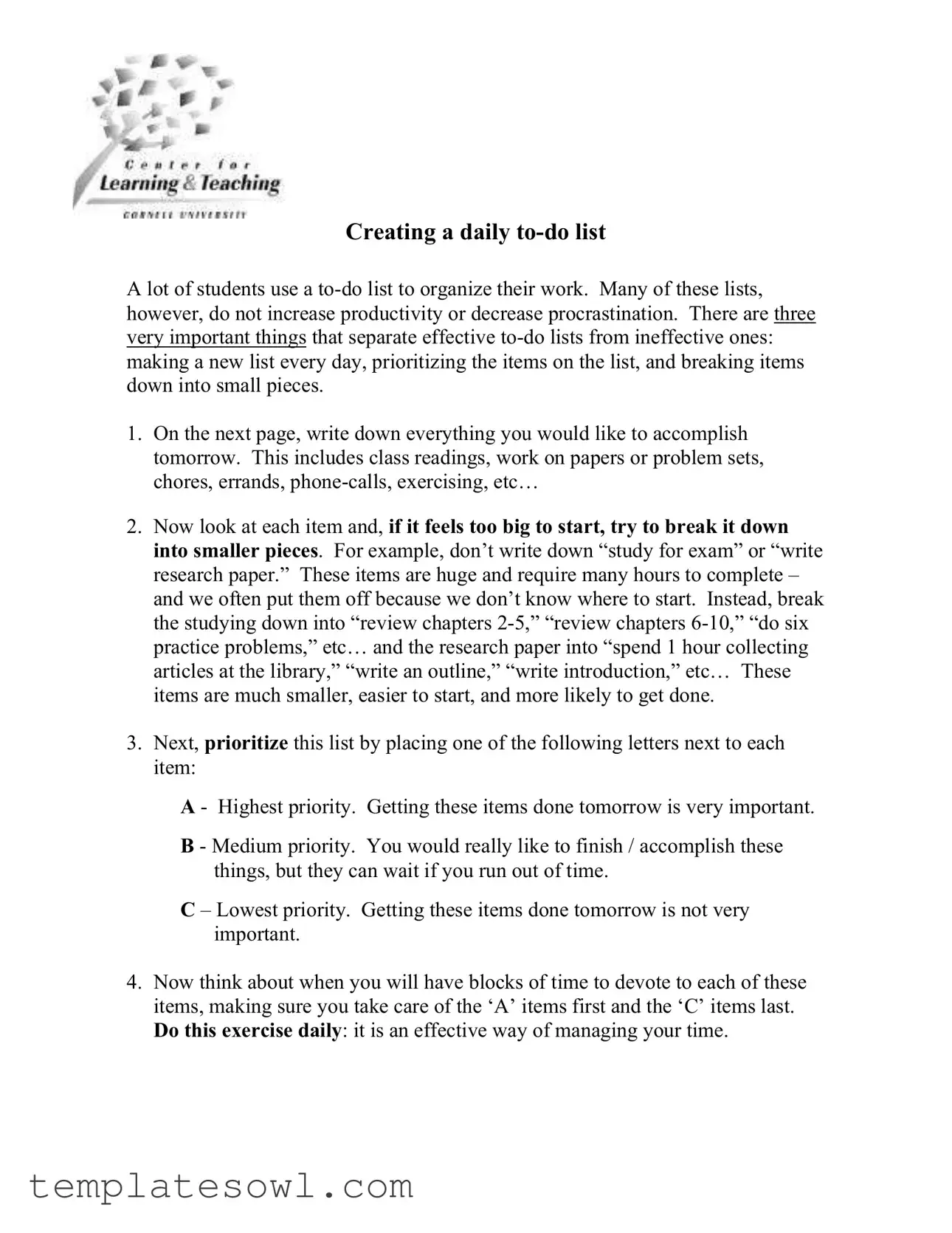What is a Daily To Do List form?
A Daily To Do List form is a simple yet effective tool designed to help individuals, particularly students, organize their tasks and manage their time more efficiently. This form encourages the user to outline specific tasks for the day, prioritize them, and break down larger tasks into manageable pieces. By using this structured approach, productivity can be enhanced, and procrastination can be minimized.
How do I create a Daily To Do List?
Creating a Daily To Do List involves a few straightforward steps. First, write down everything you want to accomplish for the following day. This could include academic tasks, chores, errands, and even personal goals such as exercising. Once you have your list, evaluate each item. If a task feels overwhelming, break it down into smaller, actionable steps. After that, prioritize the items using a simple system: label them as A (highest priority), B (medium priority), or C (lowest priority). Lastly, schedule specific time blocks for these items, focusing first on the most critical tasks.
Why is it important to make a new list every day?
Making a new list each day is crucial because it keeps your goals relevant and tailored to your current needs. Daily lists allow you to reflect on your accomplishments and adjust your focus as necessary. Additionally, this practice helps to clear your mind, making space for new ideas and priorities each day, ultimately improving your efficiency and motivation.
What happens if a task on my list feels too big to tackle?
When you encounter a task that seems overwhelming, it's essential to break it down into smaller, more manageable pieces. For instance, instead of writing "study for exam," consider jotting down specific steps like "review chapters 2-5" or "complete 10 practice problems." These smaller tasks are easier to start and complete, which can motivate you to continue working without procrastinating.
How should I prioritize tasks on my list?
To prioritize tasks effectively, use a simple labeling system. Assign each item a letter based on its significance: 'A' for highest priority tasks that need immediate attention, 'B' for medium priority tasks that are important but can wait, and 'C' for lowest priority tasks that are not urgent. This system helps you focus on what truly matters and ensures that essential tasks are completed first.
How can I ensure I complete my 'A' priority items?
To increase the chances of completing your 'A' priority tasks, consider scheduling specific time blocks in your day dedicated to these items. Look at your daily routine and identify times when you typically feel most productive. Set aside these time blocks for high-priority tasks and eliminate distractions to enhance your focus during these periods.
Can a Daily To Do List help with time management?
Yes, a Daily To Do List is a powerful tool for improving time management. By clearly outlining and scheduling tasks, you gain a better understanding of how to allocate your time effectively. The act of prioritizing and breaking tasks down not only organizes your workload but also helps you develop a realistic approach to task completion, fostering a more structured and less chaotic day.
Is it necessary to complete every item on my Daily To Do List?
No, it's not necessary to complete every item on your list, and it's perfectly normal to leave some tasks unfinished. You might encounter unexpected challenges or realize that a task isn’t as high priority as it initially seemed. Instead of feeling discouraged, use your list as a guide and carry over any incomplete tasks to the next day’s list, adjusting priorities as needed.
How can I make my Daily To Do List more effective?
To make your Daily To Do List more effective, ensure you create it daily, personalize it according to your goals, and consistently review your progress. Breaking down large tasks, prioritizing items, and scheduling specific time blocks are key components. You might also consider reflecting on the list at the end of the day to celebrate accomplishments and make adjustments for future lists, fostering a continuous improvement cycle.


